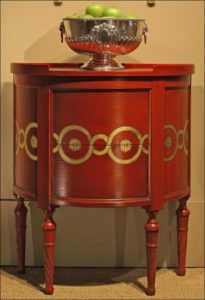It is so much of what we’ve heard over the last couple of years, that manufacturing jobs long lost to the Far East would return to this country. I don’t think flipping burgers at McDonald’s down the road from me is what would be counted as a manufacturing job. It would be interesting, within the nearby McDonald’s, to see what of their interior fittings, even their kitchen equipment, is manufactured in the US. Not much if anything, I’d wager. Where from and the why? You already know, gentle reader- overwhelmingly, the where from is China, and the why is an acquisition cost fractionally what it is to buy from a US manufacturer. For myself, I would happily pay more for a burger made not just with domestic ingredients, but also prepared using domestically made cookers and afterward to sit on domestically manufactured stools and lean on domestically made counters. In this, I suspect, I am in the distinct minority.
I mention this by way of introducing something closer to what it is we do, selling period material, and how much has been made over the last couple of years about how changing tastes have been detrimental to the trade. I saw an ad this morning on TV for the company Home Goods, which along with a number of other retailers sells job lot and end of season decorating material for home use- throw cushions, bath towels, decorative flower pots and mirrors- you know it, and you name it, they’ve got it. What you would have trouble naming, though, are the items in stock that are made in the US. Overwhelmingly, the items on offer at any of these retailers were made in low wage countries. Now mind you, nothing is very expensive, but everything is, as an old colleague of mine in the trade used to say when trying to avoid using an opprobrious term to describe third rate material, cheap and cheerful.
Not expensive, and cheap enough to be thrown away, but not very good quality, either. Hopefully biodegradable, too, as so much of it is destined in the not too distant future for the landfill. That sounds sour, and I apologize to my gentle readers, but I ask you- can you say it isn’t so? And while pundits decry the change in taste that seems to now grace the pages of the shelter publications, the internet and HGTV, bear in mind that we’ve a huge number of Chinese manufacturers that are laughing all the way to the bank. The cheap schlock that younger buyers seem so eager to acquire is likewise extremely cheap for low wage countries to produce.
Are you looking for quality and durability? Well, you won’t find it. A few months ago, we sought to replace some Fieldcrest toweling, worn out after some thirty years of use. We were able to find a local outlet that sells Fieldcrest bath linens, but although 100% cotton was clearly of an inferior manufacture. While the towels we were replacing were produced with domestic cotton and spun in a mill in North Carolina, the same brand toweling available now was made in India. A year on, and it’s worn out. Let me see- we got thirty years worth of wear out of the first set of towels that were domestically made and a year’s worth of wear out of the towels made in India. Were the domestically made towels thirty times more expensive than those made in India? Not hardly. Cheaper to acquire, yes- cheaper to own? Not hardly.
Can China, can India produce goods that are of excellent and enduring quality? Of course they can, and have a tradition of doing so that stretches back millennia. Will they do so? And that begs the question- why should they, when we want to price shop and buy looks-like- but- isn’t. For me, of course, when I see what’s on offer at Home Goods, or what graces the pages of most shelters and is broadcast on very many HGTV programs, I know that the typical viewer has never had to replace 30 year old Fieldcrest towels. In more direct terms, our own buyers these days are not only price driven, but don’t actually know domestic quality, because they’ve never seen it.

